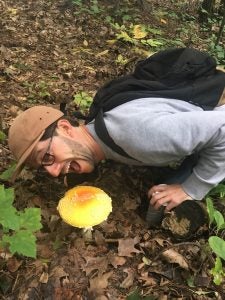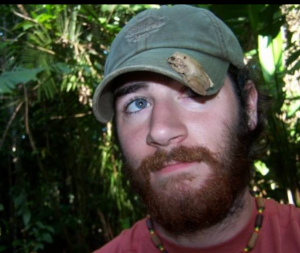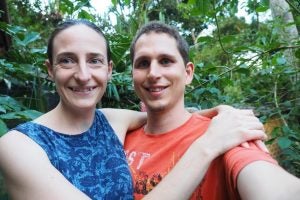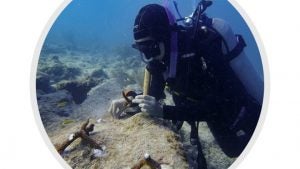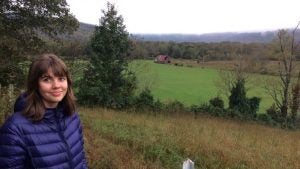Lab Members, Past and Present
This is a list of my former and current students, what they worked on in my lab (or in collaboration with me), where they are, and what they are doing now (and photos!).
Rebecca Symula

Beckie did the first molecular phylogenetic analyses of the mimetic radiation in Ranitomeya imitator, as well as phylogenetic analyses of the genus (then Dendrobates). She went on to do a PhD at the University of Texas with David Cannatella, working on systematics and the evolution of coloration in Corroboree frogs in Australia. She was a postdoctoral researcher, focusing on parasite-host coevolution, at Yale University. Beckie is currently an assistant professor at the University of Mississippi. She was a Master’s student in my lab from 1999-2001.
More photos from Beckie
Seabird McKeon
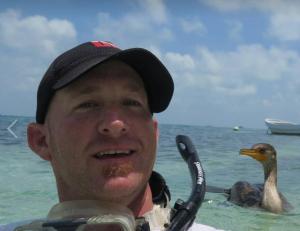
Sea McKeon completed a Master’s degree in my lab, working from 2002-2004. He worked in the Manu Biosphere reserve in southern Peru, carrying out an experimental analysis of reproductive strategies in Allobates femoralis. He went on to complete a PhD in marine ecology at the University of Florida, and has been a postdoctoral researcher with the Smithsonian Institution.
More photos from Sea
Jennifer Roberts
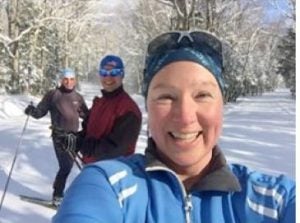
Jenny worked on the phylogenetic and phylogeographic relationships of poison frogs in Peru, especially in the Genus Amereega (Epipedobates at the time). She was in the lab from 2003-2005. Jenny is currently teaching high school biology in New Hampshire.
More photos from Jenny
Jason Lee Brown

Jason is currently an assistant professor at Southern Illinois University. He was a doctoral student at ECU from 2003-2009.
www.jasonleebrown.org
www.sdmtoolbox.org
www.paleoclim.org
Doctoral Research at ECU. The relationship between the form of parental care and the mating system within a species is an issue of fundamental importance to understanding the ecology and evolution of animal breeding systems. Despite decades of research, the specific ecological factors that drive the evolution of parental care remain a subject of debate. A large part of my doctoral on behavioral ecology examined how the nature of reproductive resources used by species crucially influences the reproductive strategies of individuals, including mating system, form of parental care, and levels of sexual conflict. In northern Peru I worked with two species of closely related poison frogs that differ in parental care strategies occur in sympatry. Ranitomeya imitator exhibits biparental care (where both parents take of their tadpoles) and R. variabilis exhibits male parental care (where only the males participate in tadpole transport and deposition). My results revealed that the transition to rearing tadpoles in tiny phytotelmata (mediated by competition and sexual conflict) drove the evolution of biparental care and monogamy in Peruvian poison frogs. We also demonstrated the first cases of brood parasitism (Brown et al. 2008 Biol. Lett.) and the first case of genetic monogamy in anurans (Brown et al. 2010 Am. Nat.).
The relationship between the form of parental care and the mating system within a species is an issue of fundamental importance to understanding the ecology and evolution of animal breeding systems. Despite decades of research, the specific ecological factors that drive the evolution of parental care remain a subject of debate, particularly in the case of vertebrates. A large part of my doctoral research on behavioral ecology examined how the nature of reproductive resources used by species crucially influences the reproductive strategies of individuals, including mating system, form of parental care, and levels of sexual conflict. To evaluate this hypothesis, I worked with S. American poison dart frogs that utilize small pools of water in arboreal plants (phytotelmata) for tadpole deposition, where they are reared to metamorphosis. We predicted that the use of extremely small, nutrient-poor pools will be associated with pair-bonding, monogamy, female participation in parental care (biparental care), and low sexual conflict, whereas the use of larger pools with sufficient nutrients will be associated with a lack of mate-fidelity, uni-parental male care, frequent reproductive parasitism, and high levels of both intra and inter-sexual conflict. In northern Peru, two species of closely related poison frogs that differ in parental care strategies occur in sympatry. Ranitomeya imitator exhibits biparental care (where both parents take of their tadpoles) and R. variabilis exhibits male parental care (where only the males participate in tadpole transport and deposition). Our results revealed that the transition to rearing tadpoles in very small phytotelmata (mediated by competition and sexual conflict) drove the evolution of biparental care and monogamy in Peruvian poison frogs. We also demonstrated the first cases of brood parasitism (Brown et al. 2008 Biol. Lett.) and the first case of genetic monogamy in anurans (Brown et al. 2010 Am. Nat.).
The Brown Lab at SIU. Species are inherently connected to the environments in which they evolve. The central theme of my research aims to understand the interplay between spatial, genetic, ecological and evolutionary processes. My lab integrates theoretical evolutionary and population genetics with geospatial modeling, field-based and molecular genetic research to address fundamental questions regarding the evolution of organisms, populations, and ecosystems. I study the spatial patterns and processes driving community structure, speciation, and morphological diversity (genetic, phenotypic and behavioral). Much of the research in my lab falls into two main focal areas:
1. Conceptual foundations & methodological tools for quantifying drivers of biodiversity. Much of Jason’s current research on this topic focuses on evaluating the genetic and demographic consequences of changes in habitat through time. The integration of geospatial and genetic data provide insights into the evolutionary mechanisms underlying recent divergences in ecology, phenotype and behavior (Brown et al. 2010 J. Biogeogr.; Brown & Knowles Mol. Ecol. 2012; Gehara, Summers & Brown 2013 Evo. Ecol.) and the genetic consequences of future climate change.
2. Diversification, speciation, and behavior of South American poison frogs. Jason’s lab also has a keen interest in the evolutionary histories of poison frogs. Several of his current projects focus on the poison frog genera: Ameerega and Ranitomeya, which recently diverged into the east Andes versant. There they rapidly radiated into 45 aposematic species. His lab has sequenced genomic data (UCEs) of over 750 tissue samples from all species in the genera from across the species’ ranges. These projects provide a rigorous framework for studying speciation, geographic variation – including widespread mimicry – and genome evolution. From a practical perspective, the systematic research clarifies the core evolutionary units, which gives meaning to the genes and genomic patterns they study and provides a starting point for biodiversity preservation. Lastly, as with much of his research program, the quantitative biogeography research provides an essential understanding why species are in their present locations.
More Photos from Jason
Evan Twomey
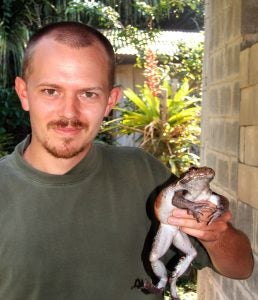
Evan did a Master’s degree in my lab, working on larval competition and divergence in Amereega in and around Tarapoto, Peru (2003-2005). He then went on to complete a PhD in my lab, working on mimcry, population divergence and incipient speciation in Ranitomeya imitator, also in and around Tarapoto, Peru (2007-2016). This was where he met his partner, Lisa Schulte (see below). Evan is now a research scientist at Frankfurt University in Frankfurt, Germany.
Lisa Schulte
Post-doctoral Reseach at ECU: Lisa was a postdoctoral researcher in the lab in 2014. During her one-year post-doc at ECU, Lisa worked on the hormonal underpinnings of parental care in Ranitomeya imitator. She tested the effect of the peptide hormones vasotocin and mesotocin, which were known to trigger aggression in anurans and parental care behavior in fish. Using ex-sito breeding pairs in the lab, she intraperitonelly injected those hormones (or their antagonists) after egg-deposition and before tadpole transport and filmed the frog´s parental care behaviours before and after the injections. It turned out that R. imitator shows two types of egg care behaviours: intense and general care. Surprisingly vasotocin did not trigger, but decreased intense egg care behaviors in both males and females. However, there was a trend for general care behavior to increase, which might explain the adverse effect regarding intense care. Mesotocin did not have an effect on egg caring behaviours, but after administration of this hormone males were less likely to transport their offspring later on (Schulte & Summers 2017, Physiol. Behav.).
Chemical communication in frogs – past, current & future reseach: Lisa completed her PhD at Trier university (Germany) in Stefan Lötter’s lab. Most of her thesis research took place in Tarapoto, Peru, which is where she met her partner, Evan Twomey (see above). She worked on chemical communication during parental care in poison frogs. Using in-situ pool-choice experiments and HPLC-MS-methods, she isolated different chemical compounds that trigger male frogs to chemically avoid both, conspecific (and cannibalistic) as well as heterospecific tadpoles when searching for rearing sites for their own offspring.
After her post-doctoral research at ECU, Lisa combined her previously gained knowledge of chemical communication with the new knowledge regarding peptide messengers, to search for peptide/protein pheromones secreted from breeding glands in South- and Central American hylids. Together with her colleges from in the Amphibian Evolution Lab at Free University of Brussels (Belgium), she found RNA- and protein-sequences which were previously only known as salamander courtship pheromones. Phylogenetic analyses suggest that salamanders and frogs share the same ancestral courtship pheromone system.
Lisa is currently an assistant professor at Frankfurt University, Germany. Since spring 2018 Lisa has her own lab for “Wildlife-/Zoo-Animal-Biology and Systematics (WZS)” at Frankfurt University. Together with her students, she keeps working on chemical communication in frogs, i.e. on the identification of courtship pheromones in both hylids and poison frogs, as well as on alarm pheromones in tadpole-schools. Combining a diverse set of methods such as next generation sequencing, histology, shot-gun proteomics and ethological approaches, they try to shed light on this highly understudied communication mode in frogs.
http://www.bio.uni-frankfurt.de/43970254/ak-schulte
More Photos from Lisa and Evan
Tiffany Kosch
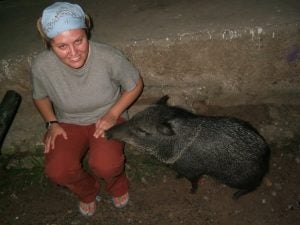
Summers’ Lab Activities
While working in the Summer’s lab, Dr. Kosch conducted the first country-wide study on the distribution and prevalence of the amphibian chytrid fungus (Batrachochytrium dendrobatidis) in Peru. She also developed methods to improve detection of Bd from skin swabs and investigated the evolution of virulence of the Bd pathogen.
Current Activities
Adjunct Research Fellow, One Health Research Group, James Cook University, Townsville, QLD, Australia
0000 0001 5158 5748
email: tiffany.kosch@jcu.edu.au
https://research.jcu.edu.au/portfolio/tiffany.kosch/
https://www.researchgate.net/profile/Tiffany_Kosch
Dr. Tiffany Kosch is currently investigating the genomic basis of immunity to the devastating amphibian fungal disease chytridiomycosis in the southern corroboree frog (Pseudophryne corroboree), an endangered amphibian endemic to the Snowy Mountains of Australia. Her goal is to use this information to improve the success of the reintroduction program for this species.
Justin Yeager

Justin Yeager completed a Master’s degree in my lab (2007-2009), working on the phylogeography of color pattern evolution in the Peruvian mimic poison frog. He went on to complete a PhD in ecology and evolution at Cori Richard-Zawacki’s lab at Tulane University, working on genetic and phenotypic (color) divergence in Oophaga pumilio in the Bocas del Toro region of Panama. He is currently an assistant professor at the Universidad de las Americas in Quito, Ecuador.
More photos from Justin
Jesse Delia
Jesse joined the Summers Lab as a master’s student to study parental care and hatching plasticity in glassfrogs. Working in Oaxaca Mexico on Hyalinobatrachium fleischmanni, he conducted a series of experiments to evaluate the function and environmental contingency of male-only egg attendance. He found that male care greatly reduces embryo dehydration, and that fathers adjust care in response to weather and associated rates of egg dehydration. Male care is extremely variable in H. fleischmanni, lasting from 2–27 days—yet its importance to embryo survival greatly declines after the first couple of days. In other frogs that lack parental care, research had demonstrated that embryos adaptively time hatching in response to risk and opportunity. For example, Red-eyed treefrog embryos can hatch early to escape egg-stage predators or delay hatching to develop longer in safe eggs. Jesse tested whether hatching plasticity might allow glassfrog embryos to cope with variable male care. Using a late-age removal experiment, he found that glassfrog embryos hatch early from abandoned eggs and delay hatching under continued care (to more than double the duration of the egg stage). While embryos in eggs might not be able to beg for care, this work supports that hatching plasticity provides a mechanism for embryos to cope with or exploit variable parenting, simply by adjusting the duration of the egg-stage.
Jesse expanded on his master’s work for his PhD thesis, investigating the evolution of parent–embryo interactions across glassfrogs, in Karen Warkentin’s lab at Boston University. Little was known about the distribution of care in this family, so he conducted behavioral observations across 40 species to examine historical changes in caregiving sex. He found that elaborate male-only care evolved ~ 3 times from simpler forms of female-only. These evolutionary transitions were correlated with changes in egg-clutch traits that determine embryo dependency, suggesting that maternally constructed clutch-phenotypes might coevolve with and maintain the importance of male care. Working across independent origins of prolonged parental care in six species, he experimentally confirmed that embryos plastically time hatching with parental abandonment, and that delayed hatching allows embryos to covert continued care into larval-stage benefits. Across species, evolutionary extensions in care duration are strongly associated with increases in hatching plasticity. Interestingly, elaborate co-extensions occur in species where promiscuous males continue mating during care periods, suggesting that social dynamics of parents might influence father–embryo evolution. He explicitly tested whether mating dynamics generate variation in male care and embryo environments by manipulating mating success in two species with independent origins of male-only care (in Hyalinobatrachium and Centrolene). In the field, he found that enhancing male mating-success substantially increased the duration of care provided to nests (weeks to months longer). While conflicts between mating and parental effort are considered to constrain the evolution of male care, this result supports that mating success has a positive influence on male-care levels across independent origins in glassfrogs. Furthermore, embryo exploit these socially driven changes in male care, as those of high-success fathers delayed hatching for weeks to double the duration of development in ovo. These results are inline with the idea that positive, reinforcing processes among family members may be elaborating paternal and embryo traits.
Jesse is starting a postdoctoral position in Lauren O’Connell’s lab at Stanford University fall 2018. He hopes to examine the proximate mechanisms of parent–embryo interactions and glassfrog coloration (or lack thereof).
Delia, J., Ramirez-Bautista, Summers, K. 2013. Parents adjust care in response to weather conditions and egg dehydration in a Neotropical glassfrog (Centrolenidae). Behavioral Ecology and Sociobiology 67:557-569.
Delia, J., Ramirez-Bautista, Summers, K. 2014. Glassfrog embryos hatch earlier after parental desertion. Proceedings of the Royal Society of London B 281: 1471–2954 (Highlighted in Science and Live Science).
More photos from Jesse
James Tumulty
James studies the evolution of animal social behaviors. As a master’s student in the Summers Lab, James studied the adaptive value of biparental care in the monogamous mimic poison frog (Ranitomeya imitator). Building on work done by Jason and Kyle on the evolutionary relationship between parental care and mating systems among poison frogs, James monitored the growth and survival of tadpoles in artificial pools in the field to directly quantify the importance of parental care. Tadpoles grew faster when they were provisioned with unfertilized eggs at higher rates, confirming the importance of female care in this species. However, removing male parents decreased growth and survival, indicating that males play an important role in coordinating egg-feeding of tadpoles. These results suggest that monogamy in mimic poison frogs is maintained because of the importance of biparental care to offspring survival; obtaining additional mates confers little benefit if the offspring from those matings don’t survive, so it is adaptive for pairs of mimic poison frogs to remain together and care for offspring.
James continued field-based research on the social behavior of poison frogs in the family Aromobatidae as a Ph.D. student at the University of Minnesota working with Mark Bee. Although they lack the bright aposematic colors of dendrobatid frogs, the nontoxic aromobatid frogs share many of the fascinating social and parental behaviors. James studied three species of aromobatid frogs in the Guyana shield to understand how reproductive ecology relates to territorial behavior and the social recognition of territory neighbors. Male golden rocket frogs (Anomaloglossus beebei) defend territories based around reproductive resources in the form of bromeliads. They call these territories and show a form of social recognition called the “dear enemy effect” in which they learn to recognize the calls of their neighbors, responding less aggressively to the calls of neighbors than the calls of unfamiliar strangers. James found that closely related terrestrial breeders, Kai rocket frogs (Anomaloglossus kaiei) and brilliant-thighed poison frogs (Allobates femoralis), do not show this behavior. He has been using comparative research among these species to learn about how social recognition evolves, both in terms of the social and ecological sources of selection for recognition and the mechanisms of communication that make it possible.
James is currently a postdoctoral researcher in Michael Sheehan’s lab at Cornell where he is employing genomic and population genetic techniques in paper wasps to understand the evolution of social recognition.
More photos from James
Adam Stuckert
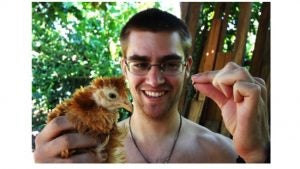
Adam competed his PhD in 2018, working on aposematic signal evolution from many different perspectives. He is currently an NSF postdoctoral researcher with Matthew MacManes at the University of New Hampshire, working on genomic analyses of color pattern evolution in poison frogs.
More photos from Adam
Mathieu Chouteau
Mathieu is a French Canadian researcher investigating the evolutionary dynamics that explain the origin and persistence of adaptive diversity within species. To get there he uses a comparative approach encompassing several study systems and combining gene identification and mutations that underlie individual variations, and ecological, evolutionary and demographic mechanisms determining their respective benefits.
Focusing on a variety of organisms (poison dart frogs and Heliconius butterflies) demonstrating an extraordinary adaptive warning signal diversity in Peru, he experimentally explored and described the geographic dynamics of adaptive landscape associated with warning signals, and analyzed how this landscape modulates the process of diversification, maintains complex phenotypes as well as shape complex mimetic communities . His research then gradually focused on the benefits and ecological costs associated with the genomic architecture that underlies the high phenotypic flexibility of these species. Establishing the link between ecological process and functional genomic provides a complete picture of the processes generating biodiversity.
Mathieu is now residing in French Guiana and work as a researcher for the Centre National de la Recherche Scientifique (CNRS) within the Laboratoire Ecologie, Environnement, Interactions des Systèmes Amazoniens (LEEISA) in Cayenne. He continues to manage the Tarapoto Research Center, a facility he created with Melanie McClure in 2011 in collaboration with the INIBICO NGO. This center provides researchers with the infrastructure to perform experiments on poison dart frogs directly in Peru.
Webpage: https://mathieuchouteau.weebly.com/
Email : mathieu.chouteau@univ-tlse3.fr
Rudolf von May

Rudolf did his PhD at FIU in Miami, but I served on his committee as an external member. Before that we collaborated on at National Geographic funded research project on Ranitomeya biolat in southern Peru (Rio Los Amigos). After completing his degree, Rudolf received an NSF fellowship to work at UC Berkeley with Craig Moritz, and then went to the University of Michigan to work with Dan Rabosky as a postdoctoral researcher.
More photos from Rudi
Ian Davison
Ian completed a Masters degree in my lab from 2012-2015, using feeding experiments to investigate sequestration of dietary alkaloid toxins from ants by Dendrobates auratus.
Miho Yoshioka
Miho Yoshioka did a Master’s degree in my lab from 2013-2015, investigating predictions from the hypothesis that begging intensity represents an honest signal of need in tadpoles.
Miho focused on parent-offspring interactions in R. imitator, specifically on the vibrational begging behavior displayed by tadpoles in the presence of one or both parents. Designed In the general context of honest signaling theory, her research tested modified hypotheses posed by Godfray’s offspring signaling theory—key conditions that would allow a begging signal to persist as an evolutionarily stable strategy. Through a series of laboratory experiments involving analysis of video-recorded tadpole behavior, she found the following to be supported: begging effort or intensity reflects offspring energy reserves (begging is an honest signal of need), begging imposes a cost to offspring development and parental food provisioning depends on offspring need (providing more care to less developed offspring in the form of more frequent feedings).
The study was supplemented with 4 months of fieldwork conducted in the Cordillera Escalera Conservation Area, Tarapoto, Peru. There, she successfully captured in real-time, video footage of tadpole begging behavior in the species’ natural habitat.
In 2014, she presented her work at a conference hosted by the Colombian Congress of Zoology in Cartagena, Colombia and later published the research in the journal Animal Behaviour.
Miho currently (2018) works as a Biological Science Laboratory Technician in the Crop Bioprotection Research Unit at the National Center for Agricultural Utilization Research, Agricultural Research Service, USDA in Peoria, IL. For two and a half years, she tested ways to improve the stress tolerance and thereby the control efficacy of select microbes against fungal diseases in wheat and potatoes. In June, 2018 she was transferred to a more molecular biology-focused lab, where she currently screens for biocontrol candidates from mosquitoes and insect crop pests.
More photos from Miho
Andrew Rubio
I am from the city the never sleeps, New York City. I obtained my Bachelor’s degree in Zoology from SUNY Oswego, where I took a great interest in the conservation of Neotropical amphibians. I obtained my Master’s degree in Zoology at Southern Illinois University-Carbondale, where my main focus was on the effect of the fungal pathogen Batrachochytrium dendrobatidis on High Andean Water frogs of the genus Telmatobius. My research in the Summers lab will be focused on the genetic underpinnings of mimicry and color pattern evolution in the Peruvian mimic poison frog, Ranitomeya imitator. I hope to undertake projects that are aimed at investigating patterns of differential gene expression between morphs and identifying candidate genes for color in R. imitator. These projects will provide important insights on the evolution of color pattern in poison dart frogs.
Profiles: ResearchGate |
Emily White

Emily is currently a Master’s student in my lab. Her research is focused on the molecular underpinnings of traits that affect evolutionary fitness, such as aposematic coloration and mating and parental care behaviors. For her thesis, she is investigating the genetics of skin color pattern in the mimic poison frog, Ranitomeya imitator. She is also involved in a project comparing brain gene expression in R. imitator and Dendrobates auratus, species of poison frogs that exhibit contrasting mating and parental care behaviors. In her free time, Emily enjoys being outdoors, spending time with her family, and playing with her cat JoJo.
More Photos from Emily
Mallory de Araujo Miles
Mallory Miles is currently working towards her master’s degree in my lab (2019 – 2021). She is studying the expression of candidate genes which may lead to differential color expression across Ranitomeya imitator morphs. Mallory is using a list of color candidate genes prepared by previous Summers lab members and genetic probes developed by collaborators at UC Berkeley to perform in situ hybridization on whole frog embryos. If all goes well, ISH should reveal differentiation in gene expression between color morphs, as well as localization of gene expression and the developmental stage in which genes are expressed. Mallory will also be staining histological slides to examine structural differences between chromatophores in skin sections of various colors.

